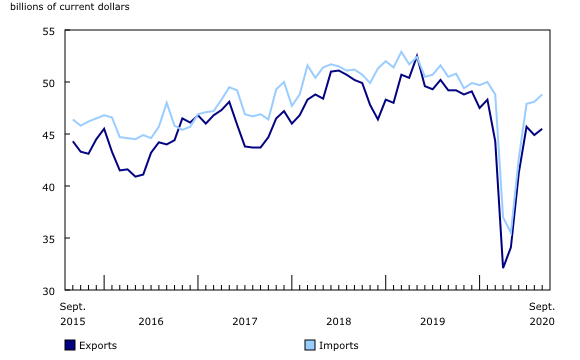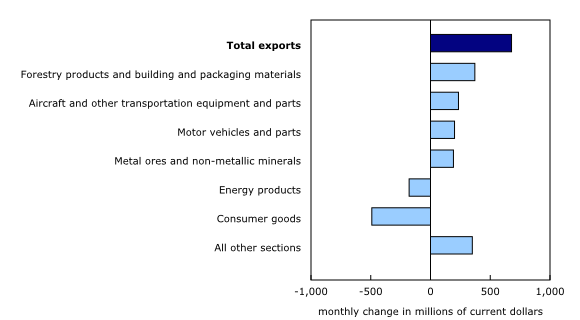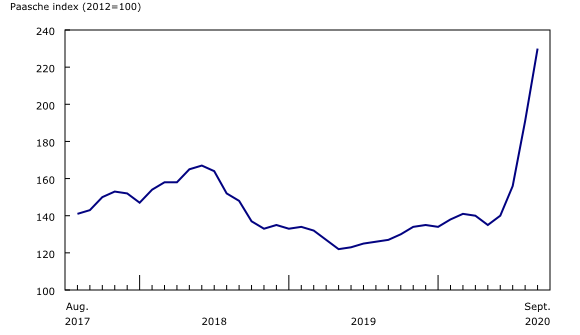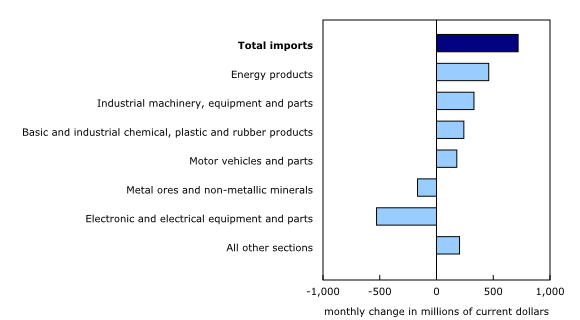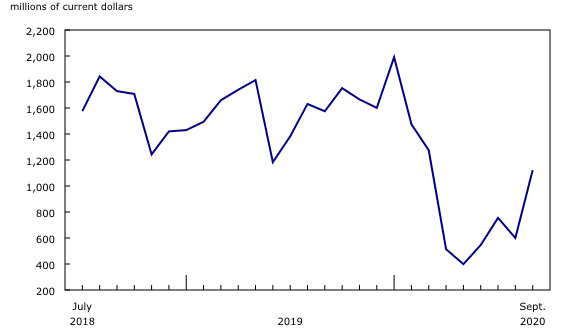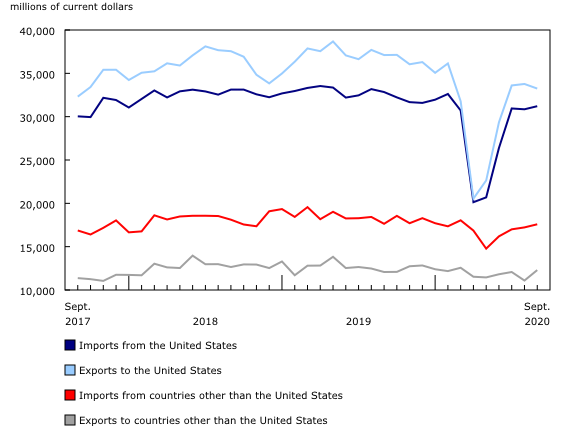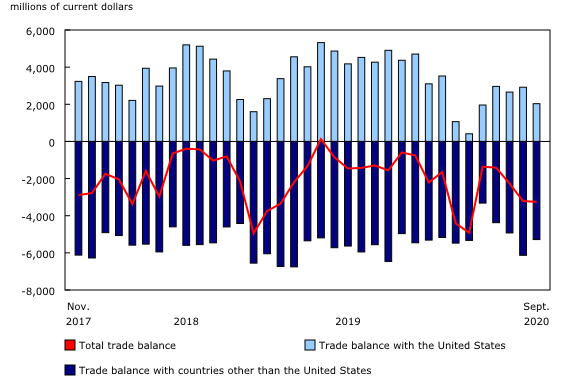Canadian international merchandise trade, September 2020
Archived Content
Information identified as archived is provided for reference, research or recordkeeping purposes. It is not subject to the Government of Canada Web Standards and has not been altered or updated since it was archived. Please "contact us" to request a format other than those available.
Released: 2020-11-04
In September, Canada's merchandise exports rose 1.5%, led by higher exports of lumber and aircraft, while imports were also up 1.5%, mainly on higher crude oil imports. As a result, Canada's merchandise trade deficit with the world widened slightly from $3.2 billion in August to $3.3 billion in September.
To explore the most recent results from Canada's international merchandise trade in an interactive format, see the new "International merchandise trade monthly interactive dashboard."
Exports of lumber rise for a fifth consecutive month
Total exports rose 1.5% in September to $45.5 billion—this was $2.8 billion short of the levels posted in February, before the COVID-19 pandemic. In September, 8 of 11 product sections increased, and non-energy exports were up 2.2%. In real (or volume) terms, total exports increased 1.2%.
Exports of forestry products and building and packaging materials rose 10.4% in September to $3.9 billion. This is a 15.5% increase compared with February. Exports of lumber (+23.0%) contributed the most to the overall growth, up for a fifth consecutive month to reach $1.6 billion, the highest level in 14 years. As was the case with the monthly increases observed in lumber exports since July, the September gain was mainly the result of higher prices. The latest release of the Industrial product and raw materials price indexes explains that combined lower supplies and higher demand (construction work and home renovation) were behind rising lumber prices in recent months. The export price index for lumber and other sawmill products reached a record high in the third quarter of 2020.
Exports of aircraft and other transportation equipment and parts rose 13.4%, mainly on increased exports of aircraft (+43.4%). September saw higher exports of business jets to the United States, Norway and the United Kingdom.
Exports of motor vehicles and parts (+2.7%) also increased in September, mainly because of higher exports of passenger cars and light trucks (+4.2%). As of September, exports of passenger cars and light trucks have surpassed the pre-pandemic level for three consecutive months.
These increases were attenuated by a significant drop in exports of consumer goods (-8.0%). This was mainly the result of lower exports of pharmaceutical products (-30.9%), due in part to decreased exports of medication used in the treatment of depressive disorders. High levels of exports of pharmaceutical products were observed in the first half of 2020 and, despite the September decline, these exports were up 5.6% over the January-to-September period compared with the same period in the previous year. Exports of miscellaneous goods and supplies also decreased, mainly on lower exports of precious metals and gold coins to the United States.
Resurgence in imports of crude oil
Total imports increased 1.5% in September to reach $48.8 billion—this was $1.2 billion lower than the pre-pandemic level in February. Of the 11 product sections, 7 increased. In real (or volume) terms, imports were up 0.6%.
Imports of energy products rose 28.8% in September to $2.1 billion, which was still 24.4% below February levels. Imports of crude oil (+87.1%) were behind the increase this month, surpassing the $1 billion mark for the first time since March. September's increase was volume-driven, with Canadian refineries purchasing more crude oil from Louisiana. While the import value for crude oil was on average $1.6 billion per month in 2019, it dropped to $563 million between the months of April and August 2020.
Imports of industrial machinery, equipment and parts rose 6.7% to $5.2 billion in September. This was the fourth increase in the past five months for the product section, although the September level remained 2.5% lower than the level observed in February. All subcategories increased in September, but imports of other general-purpose machinery and equipment (+8.7%) and logging, construction, mining, and oil and gas field machinery and equipment (+23.7%) contributed the most to the gain in the section, mainly on higher imports from the United States.
Imports of basic and industrial chemical, plastic and rubber products were up 7.6% in September. Imports of lubricants and other petroleum refinery products rose 38.5%, mainly on higher imports from the United States. This product category includes diluents used by the Canadian oil industry to ship heavy crude oil by pipeline to the United States. In September, this product rose on higher volumes as well as higher prices.
These increases were partially offset by lower imports of electronic and electrical equipment and parts (-8.7%), which decreased substantially in August and September, following strong increases in June and July. Since June, monthly movements for this product section have been mainly driven by imports of communication, and audio and video equipment, a category largely composed of cellphones. Imports of cellphones tend to be highly seasonal, and the pandemic resulted in the cellphone industry introducing new models outside the typical release cycle. This caused irregular fluctuations in monthly imports.
Exports to countries other than the United States up sharply
After declining 8.1% in August, exports to countries other than the United States rose 10.9% to $12.3 billion, the strongest increase since June 2018. Exports to the United Kingdom (gold and aircraft), Norway (aircraft and nickel) and Germany (copper and various other products) contributed the most to the growth. With the September increase, exports to countries other than the United States surpassed February levels.
Imports from countries other than the United States rose 2.1% in September to $17.6 billion. This represents a fourth consecutive monthly increase. There were higher imports from Japan (gold and passenger cars and light trucks), as well as from Italy (various). Imports from countries other than the United States also surpassed February levels in September.
Canada's trade deficit with countries other than the United States narrowed from $6.1 billion in August to $5.3 billion in September.
Exports to the United States decreased 1.6% to $33.2 billion in September, while imports were up 1.2% to $31.2 billion. As a result, Canada's trade surplus with the United States narrowed from $2.9 billion in August to $2.0 billion in September. Compared with February, both exports (-8.0%) and imports (-4.3%) with the United States declined.
When the average exchange rates of August and September are compared, the Canadian dollar was stable relative to the American dollar.
Trade surges on a quarterly basis, but remains largely below 2019 levels
On a quarterly basis, exports were up 26.8% in the third quarter, mainly on higher exports of motor vehicles and parts, as well as energy products. However, when the third quarter of 2020 is compared with the last quarter of 2019 (the last quarter that was not affected by the pandemic), exports were still down 7.5%. Exports of energy products showed the largest decline between the two periods, mainly because of lower prices. In contrast, exports of farm, fishing and intermediate food products were up 26.4% in the third quarter of 2020 compared with the last quarter of 2019. This was mainly the result of significant increases observed in exports of wheat, canola, pulse crops (peas and lentils) and other crop products.
Imports were up 25.9% in the third quarter compared with the previous quarter, led by imports of motor vehicles and parts and consumer goods. However, when the third quarter of 2020 is compared with the last quarter of 2019, imports were still down 3.5%, mainly on lower imports of energy products. In contrast, imports of metal and non-metallic mineral products and of metal ores and non-metallic minerals were both up in the third quarter compared with the last quarter of 2019, reflecting the rise in imports of gold. Imports of consumer goods also increased, mainly because of higher imports of personal protective equipment.
Using the Fisher formula, exports in constant dollars rose 17.7% in the third quarter, with exports of motor vehicles and parts posting the largest increase. Imports in constant dollars rose 25.1% in the third quarter, again mostly because of higher imports of motor vehicles and parts.
Revisions to August merchandise exports and imports
Imports in August, originally reported as $47.4 billion in the previous release, were revised to $48.1 billion in the current month's release. Exports in August, originally reported as $44.9 billion in the previous release, were essentially unchanged in the current month's release.
Trade in medical and protective goods
Imports of medical and protective goods decreased 2.2% to $3.1 billion on a customs basis in September, but were higher on a year-over-year basis. Month over month, imports in September were lower for medical equipment and products (-8.2%), disinfectant and sterilization products (-27.0%) and personal protective equipment (-6.4%). These decreases were moderated by higher imports of diagnostic products (+47.2%). Exports of medical and protective goods also declined in September, down 21.8% to $1.3 billion. Exports of medical equipment and products fell 31.3%, following a 13.8% increase in August.
Monthly trade in services
In September, monthly service exports were down 2.5%, to $9.1 billion, and service imports increased 1.2%, to $9.1 billion.
When international trade in goods and services combined is considered, exports increased 0.8% in September to $54.6 billion, while imports rose 1.5%, to $57.9 billion. As a result, Canada's trade deficit with the world for goods and services combined was $3.2 billion in September.
Note to readers
Merchandise trade is one component of Canada's international balance of payments (BOP), which also includes trade in services, investment income, current transfers, and capital and financial flows.
International trade data by commodity are available on both a BOP and a customs basis. International trade data by country are available on a customs basis for all countries, and on a BOP basis for Canada's 27 principal trading partners (PTPs). The list of PTPs is based on their annual share of total merchandise trade—imports and exports—with Canada in 2012. BOP data are derived from customs data by making adjustments for factors such as valuation, coverage, timing and residency. These adjustments are made to conform to the concepts and definitions of the Canadian System of National Accounts.
For a conceptual analysis of BOP-based data versus customs-based data, see "Balance of Payments trade in goods at Statistics Canada: Expanding geographic detail to 27 principal trading partners."
For more information on these and other macroeconomic concepts, see the Methodological Guide: Canadian System of Macroeconomic Accounts (13-607-X) and the User Guide: Canadian System of Macroeconomic Accounts (13-606-G).
Data in this release are on a BOP basis and are seasonally adjusted. Unless otherwise stated, values are expressed in nominal terms, or current dollars. References to prices are based on aggregate Paasche (current-weighted) price indexes (2012=100). Movements within aggregate Paasche prices can be influenced by changes in the share of values traded for specific goods, with sudden shifts in trading patterns—as observed currently with the pandemic—sometimes resulting in large movements in Paasche price indexes. Volumes, or constant dollars, are calculated using the Laspeyres formula (2012=100) unless otherwise stated.
For information on seasonal adjustment, see Seasonally adjusted data – Frequently asked questions.
Revisions
In general, merchandise trade data are revised on an ongoing basis for each month of the current year. Current-year revisions are reflected in both the customs-based and BOP-based data.
The previous year's customs-based data are revised with the release of data for the January and February reference months, and thereafter on a quarterly basis. The previous two years of customs-based data are revised annually, and revisions are released in February with the December reference month.
The previous year's BOP-based data are revised with the release of data for the January, February, March and April reference months. To remain consistent with the Canadian System of Macroeconomic Accounts, revisions to BOP-based data for previous years are released annually in December with the October reference month.
Factors influencing revisions include the late receipt of import and export documentation, incorrect information on customs forms, the replacement of estimates produced for the energy section with actual figures, changes in merchandise classification based on more current information, and changes to seasonal adjustment factors.
Revised data are available in the appropriate tables.
Real-time data table
Real-time table 12-10-0120-01 will be updated on November 16.
Next release
Data on Canadian international merchandise trade for October will be released on December 4.
Products
The product International merchandise trade monthly interactive dashboard (71-607-X) is now available. This new interactive dashboard is a comprehensive analytical tool that presents monthly changes in Canada's international merchandise trade data on a balance of payments basis, fully supporting the information presented every month in the Daily text.
The product The International Trade Explorer (71-607-X) is now available online.
Customs-based data are now available in the Canadian International Merchandise Trade Database (65F0013X).
The updated Canada and the World Statistics Hub (13-609-X) is now available online. This product illustrates the nature and extent of Canada's economic and financial relationship with the world using interactive graphs and tables. This product provides easy access to information on trade, investment, employment and travel between Canada and a number of countries, including the United States, the United Kingdom, Mexico, China, Japan, Belgium, Italy, the Netherlands and Spain.
Contact information
For more information, contact us (toll-free 1-800-263-1136; 514-283-8300; STATCAN.infostats-infostats.STATCAN@canada.ca).
To enquire about the concepts, methods or data quality of this release, contact Benoît Carrière (613-415-5305; benoit.carriere@canada.ca), International Accounts and Trade Division.
- Date modified:



